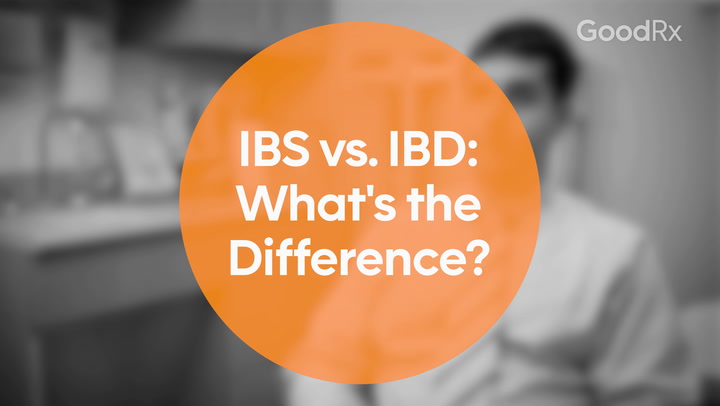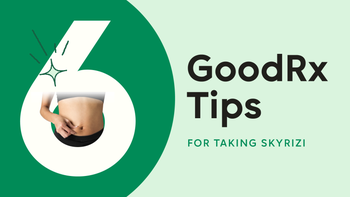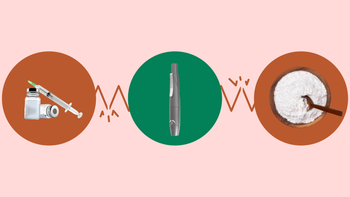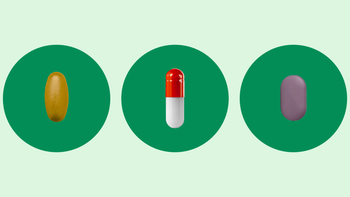
The True Cost of Crohn’s Disease
Crohn’s disease, which causes chronic inflammation of the gastrointestinal tract, usually doesn’t come to mind when we think of pricey medical conditions. But for people who have it, the expenses can add up.

Treating the disease usually requires medication and regular doctor’s visits. But even if you do everything right, you can still experience symptom flare-ups that can make it extremely difficult to accomplish everyday tasks. Symptoms can even get in the way of doing your job.
GoodRx estimates that the average insured person with Crohn’s spends over $1,300 per year managing their condition. The major costs are medications, lost wages from missed work, and doctor’s visits.
But the actual cost is even higher for most patients. As part of our research, we surveyed 261 Americans who had Crohn’s or both Crohn’s and psoriasis to learn more about their experiences and costs. Over 60% of participants had at least one other chronic condition in addition to Crohn’s. Many participants also struggled with mental health conditions, which can not only cost money to treat but can affect overall well-being and productivity. And many people with Crohn’s will eventually need surgery, which can cause the total cost of treating the condition to skyrocket.
In the pages that follow, we’ll dive deeper into these numbers, focusing on the three big buckets of spending when it comes to treating Crohn’s: medications, lost wages, and doctor’s visits. We’ll also touch on other costs that patients commonly have to deal with and offer some tips for bringing down the cost of Crohn’s medications.
What is Crohn’s disease?
Crohn’s disease causes inflammation and irritation of the digestive tract. It is an autoimmune disease, which means the body mistakenly attacks healthy cells — in this case, cells in the digestive tract.
Crohn’s is a chronic condition that’s estimated to affect up to half a million people in the U.S. It usually begins to develop in a person’s 20s. People with a family member that has an inflammatory bowel disease are more at risk.
The condition often develops slowly and becomes worse over time. Common symptoms of Crohn's disease include:
Diarrhea
Cramping and pain in the abdomen
Weight loss
Many people with Crohn’s often have periods of time when their symptoms are more active. This is followed by periods when symptoms are not present (in remission). When symptoms reappear after being in remission, they’re known as “flares.”
A large number of people with Crohn’s also have other conditions (known as comorbidities), including:
Crohn’s disease is mainly managed through medications. But even with medications, many people will still need surgery to treat complications and improve symptoms. In one study, 60% of people needed surgery within 20 years of having Crohn’s disease.
Medication costs for Crohn’s
Crohn’s medications don’t cure the disease, but they can help to control symptoms. Since Crohn’s is an autoimmune disease, many of these drugs work by suppressing the immune system.
Common medications used to treat Crohn’s include:
Aminosalicylates (Lialda, Azulfidine, Delzicol): can treat mild to moderate symptoms and help prevent relapse
Corticosteroids (Prednisone, Methylprednisolone, Cutivate): can treat moderate to severe symptoms
Immunomodulators (Azathioprine, Cyclosporine, Tacrolimus): used to treat symptoms when aminosalicylates and corticosteroids aren’t effective
Biologics and biosimilars (Adalimumab, Infliximab, Natalizumab): also used when other medications haven’t worked
Antibiotics (Ciprofloxacin, Ampicillin, Metronidazole): used to treat bacterial infections caused by Crohn’s
As with many prescription medications, these drugs aren’t cheap. We found that the average Crohn’s patient with insurance spends $606 a year on drugs to treat their condition.
Patients who take biologics see particularly staggering costs. Biologics are medications made up of living organisms. They tend to come with a high price tag because they treat rare conditions and are made from more complex materials than other drugs.
Many of the most commonly used biologics for Crohn’s can cost several thousand dollars for a typical fill. Some, such as Stelara, run up to almost $40,000 per fill. One study found that even though less than 20% of people with inflammatory bowel diseases such as Crohn’s take biologics, they see 2 to 3 times the total costs of care per year compared with people who don’t take them.
Non-biologic prescription medications for Crohn’s (which include aminosalicylates, corticosteroids, and immunomodulators) are often cheaper, though they can vary widely in price — anywhere from $11 (Prednisone) to $3,423 (Xifaxan) for a typical fill.
These costs can lead patients to take drastic measures. In our survey:
75% of respondents reported making at least one change in their care due to the cost of drugs or a surgical procedure.
30% of respondents delayed a refill after running out of a medication.
26% rationed their Crohn’s medication to extend a prescription.
16% stopped taking a medication entirely.
7% of respondents reported getting a treatment for Crohn’s from another country.
Finally, many people with Crohn’s use over-the-counter (OTC) medications for pain management. We found that the annual cost of these medications can vary depending on the number of flare-ups a person has. People who have two to three flare-ups a month spend about $43 a year on OTC drugs, while those who only have a few flare-ups a year spend about $8 a year.
Lost wages from Crohn’s
Besides paying for medications, people with Crohn’s may face other costs if they have to miss work due to their illness. Over the course of a year, these losses can add up to hundreds of dollars. We found that the average person with Crohn’s loses $511 in wages per year and misses 3.1 days of work due to Crohn’s.
In our survey, almost half of the respondents reported missing work due to their Crohn’s, and 14% said they lost their job because of their disease.
Missing work can also lead to other costs for people with Crohn’s. If they can’t work because of their illness and lose their job, they may risk losing their employer-sponsored health insurance, which often helps them afford their medications and healthcare provider visits.
Even if they don’t lose their job, patients may see other economic losses related to reduced productivity at work and at home. In fact, 43% of survey respondents said they were unable to perform daily tasks because of their Crohn’s.
Doctor’s visit costs
People with Crohn’s may need to see a variety of doctors and specialists to diagnose, treat, and manage their condition. If they have moderate to severe Crohn’s, they may need to see their provider(s) several times a year.
We estimate that the average Crohn’s patient with insurance spends $224 per year on doctor visits.
In our survey, 35% of respondents saw a healthcare provider 1 to 2 times a year, while 37% saw a provider 3 to 4 times a year, and 21% saw a provider 5 or more times a year.
Other costs
In addition to the costs outlined above, people with Crohn’s often have to shoulder other costs as well. Some of these are measurable, while others are harder to measure but can still have a major impact on a person’s quality of life.
One of the steepest of these costs is surgery, which is common for Crohn’s patients. As we mentioned earlier, 60% of people with Crohn’s disease will need surgery at some point. Some people may need bowel resection surgery (a colectomy) to remove diseased parts of the colon due to cancer.
For people with Crohn’s who have insurance, a 2017 study found that the average allowed cost for the combined inpatient and 30-day discharge period for this surgery was $36,395 for laparoscopic surgery (which is less invasive and involves fewer incisions) and $44,226 for traditional open surgery. Again, not exactly pocket change.
People with Crohn’s also frequently suffer from psoriasis, asthma, osteoporosis, and depression and/or anxiety. Managing these conditions comes with its own costs and can take a toll on mental well-being. People who have Crohn’s and mental health diagnoses have average costs that are roughly twice that of those without mental health diagnoses. In our survey, almost 50% of respondents said they’d experienced depression or anxiety because of their Crohn’s, and 43% said they’d skipped social events because of their condition.
Summing it all up
Based on our analysis, the average insured Crohn’s patient can spend over $1,300 a year taking care of their condition. But for many people with Crohn’s, that number is probably much higher. Losing insurance coverage or dealing with related conditions, such as surgery for colon cancer, can push the cost up by several thousand dollars.
If you’re a person with Crohn’s, or have a loved one with the disease, here are some ways you can save on the cost of your medications:
1) Use your insurance. Find out if your insurance (whether it’s private or Medicare) covers your Crohn’s medications. If it doesn’t, ask your healthcare provider about filing an appeal for coverage. They may be able to submit a letter to the insurance company that explains why you need the medication. Or you can ask your provider about alternative medication options that your plan will cover.
2) Fill a 90-day supply. Filling a 90-day supply instead of a 30-day supply might help you save on the cost of your medication. Larger supplies of medications are usually cheaper and require fewer trips to the pharmacy, and they have fewer copays if you’re using insurance.
3) Take advantage of a manufacturer copay card. Manufacturers of certain Crohn’s medications may offer copay cards that can reduce how much you pay out of pocket for the medication. Check the manufacturer’s website to see if they offer one. Keep in mind that you need insurance to use this option.
4) Use a patient assistance program. Drug manufacturers may also offer patient assistance programs that might help you access certain medications at little to no cost. However, you must meet eligibility requirements based on income and insurance.
5)Fill your prescription at a preferred pharmacy. Many insurance plans have a list of pharmacies with which they contract to offer lower copays on prescriptions. Some preferred pharmacy networks include mail order pharmacies. If you have insurance, see if your plan offers lower copays for your medication at preferred retail or mail order pharmacies.
6) Shop around. Use price comparison sites like GoodRx to find the lowest price for your medication at pharmacies in your area. You can’t use GoodRx and insurance at the same time, but you can use GoodRx instead of private or government-funded insurance.
Methodology
Average annual out-of-pocket spending on Crohn's: Average annual out-of-pocket spending for medication, office visits, outpatient and inpatient hospital visits, ER visits, and home health were calculated using the Medical Expenditure Panel Survey (MEPS) from 2015 to 2018. Specifically, we used the Full Year Consolidated Data Files (H-C181, HC-192, HC-201, HC-209), Medical Conditions Files (HC-180, HC-190, HC-199, H-207), Prescribed Medicines Files (HC-178A, HC-188A, HC-197A, HC-206A), Inpatient and Outpatient Stay Files, Emergency Department Files, Office-Based Visit Files, and Home Health Files. We identified Crohn’s patients as having at least one expenditure with a primary diagnosis of Crohn’s Disease, using ICD-10 code K50. Medical events were identified as Crohn's-related if the primary diagnosis for the event had a three-digit ICD-10 code of K50.
Average retail price of Crohn’s medications: This GoodRx analysis is based on a representative sample of U.S. prescription fills (not GoodRx fills) and comes from several sources, including pharmacies and insurers. The reported prices are based on average retail prices, the so-called “usual and customary” prices or retail prices at the pharmacy (not including insurance copays or coinsurance). All prices listed in this article are based on data from January 1, 2021 to June 30, 2021.
Average cost of OTC Crohn’s disease medication: This analysis is based on prices for three generic over-the-counter Crohn's medications and four over-the-counter products that help relieve Crohn's disease symptoms. Medication prices were found across five online medical supplies sources: Amazon, Walgreens, CVS Pharmacy, Walmart, and GoodRx. Product prices were found across Amazon, Walgreens, CVS Pharmacy, and Walmart.
Estimated average lost wages due to absenteeism: This analysis is based on 2015 to 2018 MEPS data for Crohn's patients. An average daily wage for Crohn's patients was estimated using the wage income variable, using 252 working days per year as the daily rate. Estimated average lost wages were calculated as the average daily wage for Crohn's patients, multiplied by the average number of days of work missed due to illness for Crohn’s patients. This is likely a conservative estimate, as the wage income variable is top-coded for confidentiality and may include Crohn’s patients who are not working.
Why trust our experts?


References
Byrne, G., et al. (2017). Prevalence of anxiety and depression in patients with inflammatory bowel disease. Canadian Journal of Gastroenterology and Hepatology.
Crohn’s & Colitis Foundation. (n.d.). Medication options for Crohn’s disease.
Crohn’s & Colitis Foundation. (2015). Fact sheet.
Crohn’s & Colitis Foundation. (2019). Managing flares and IBD symptoms.
Fitch, K., et al. (2017). Cost comparison of laparoscopic colectomy versus open colectomy in colon cancer. Current Medical Research and Opinion.
Kuenzig, M. E., et al. (2018). Co-occurrence of asthma and the inflammatory bowel diseases: A systematic review and meta-analysis. Clinical and Translational Gastroenterology.
Najarian, D. J., et al. (2003). Connections between psoriasis and Crohn's disease. Journal of the American Academy of Dermatology.
National Institute of Diabetes and Digestive and Kidney Diseases. (2017). Definition & facts for Crohn’s disease.
National Institute of Diabetes and Digestive and Kidney Diseases. (2017). Symptoms & causes of Crohn’s disease.
National Institute of Diabetes and Digestive and Kidney Diseases. (2017). Treatment for Crohn’s disease.
Park, K. T., et al. (2019). The cost of inflammatory bowel disease: An initiative from the Crohn’s & Colitis Foundation. Inflammatory Bowel Diseases.























